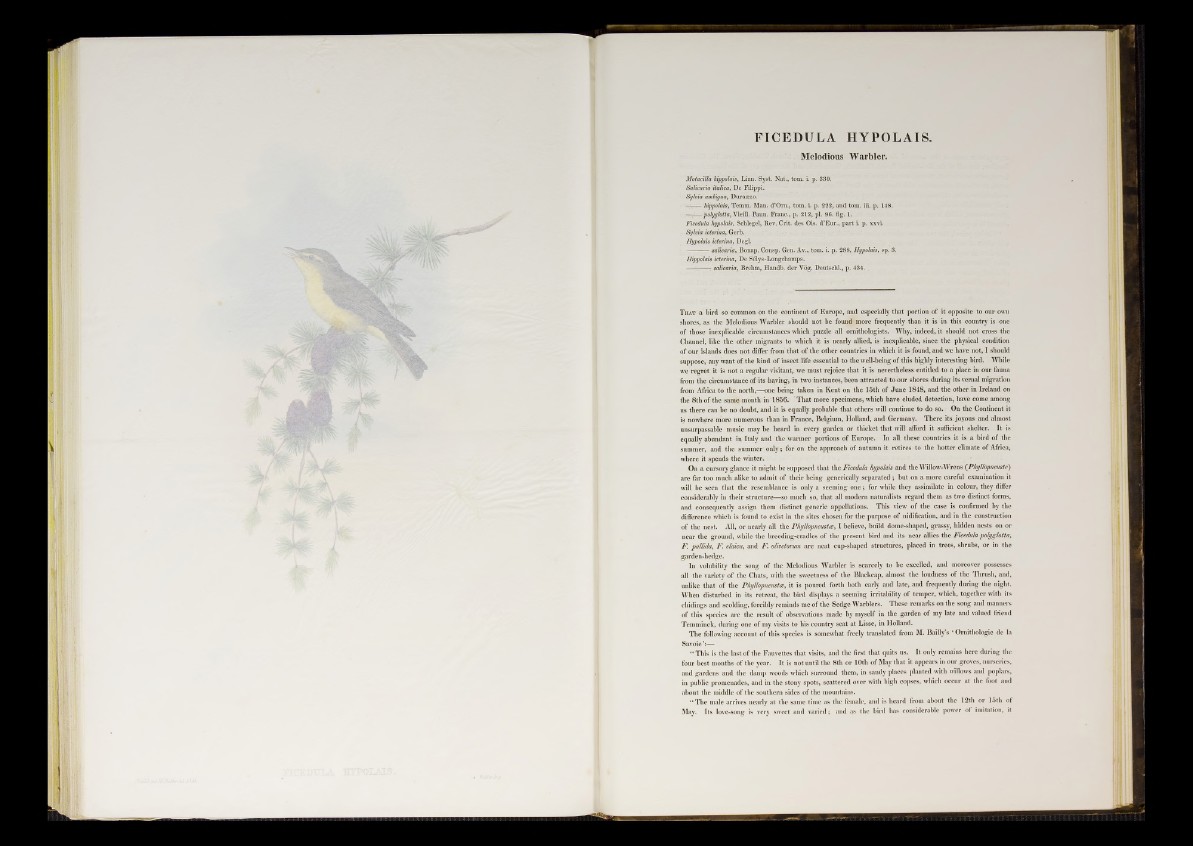
Motacilla hippolais, Linn. Syst. Nat., tom. i. p. 330.
Salicaria itálica, De Filippi.
Sylvia ambigua, Durazzo.
hippolais, Temm. Man. d’Orn., tom. i. p. 222, and tom. iii. p. 148.
-— polyglotta, Vieill. Faun. Franc., p. 212, pl. 96. fig. 1.
Ficedula hypolais, Schlegel, Rev. Crit. des Ois. d’Eur., part i. p. xxvi.
Sylvia icterina, Gerb.
Hypolais icterina, Degl.
----------■salicaria, Bonap. Consp. Gen.Av., tom. i. p. 288, Hypolais, sp. 3.
Hippolais icterina, De Sélys-Longcbamps.
— : salicaria, Bréhm, Handb. der Vog. Deutschl., p. 434.
T hat a bird so common on the continent of Europe, and especially that portion of it opposite to our own
shores, as the Melodious Warbler should not be found more frequently than it is in this country is one
of those inexplicable circumstances which puzzle all ornithologists. Why, indeed, it should not cross the
Channel, like the other migrants to which it is nearly allied, is inexplicable, since the physical condition
of our islands does not differ from that of the other countries in which it is found, and we have not, I should
suppose, any want of the kind of insect life essential to the well-being of this highly interesting bird. While
we regrét it is not a regular visitant, we must rejoice that it is nevertheless entitled to a place in our fauna
from the circumstance of its .having, in two instances, been attracted to our shores during its vernal migration
from Africa to the north,—one being taken in Kent on the 15th of June 1848, and the other in Ireland on
the 8th o f the same month in 1856. That more specimens, which have eluded detection* have come among
us there can be no doubt, and it is equally probable that others will continue to do so. On the Continent it
i§ nowhere more numerous than in France, Belgium, Holland, and Germany. There its joyous and almost
unsurpassable music may be heard in every garden or thicket that will afford it sufficient shelter. It is
equally abundant in Italy and the warmer portions of Europe. In all these countries it is a bird of the
summer, and the summer only; for on the approach of autumn it retires to the hotter climate of Africa,
where it spends the winter. .
On a cursory glance it might be supposed that the Ficedula hypolais and the Willow-Wrens (' Phyllopneuste)
are far too much alike to admit of their being generically separated ; but on a more careful examination it
will be seen that the resemblance is only a seeming o n e ; for while they assimilate in colour, they differ
considerably in their structure—so much so, that all modern naturalists regard them as two distinct forms,
and consequently assign them distinct generic appellations. This view o f the case is confirmed by the
difference which is found to exist in the sites chosen for the purpose of nidification, and in the construction
of the nest. All, or nearly all the Phyllopneustce, I believe, build dome-shaped, grassy, hidden nests on or
near the ground, while the breeding-cradles of the present bird and its near allies the Ficedula polyglotta,
F. pallida, F. elaica, and F. olivetorum are neat cup-shaped structures, placed in trees, shrubs, or in the
garden-hedge.
In volubility the song of the Melodious Warbler is scarcely to be excelled, and moreover possesses
all the variety of the Chats, with the sweetness of the Blackcap, almost the loudness of the Thrush, and,
unlike that of the Phyllopneustce, it is poured forth both early and late, and frequently during the night.
When disturbed in its retreat, the bird displays a seeming irritability of temper, which, together with its
chidings and scolding, forcibly reminds me of the Sedge Warblers. These remarks on the song and manners
of this species are the result of observations made by myself in the garden of my late and valued friend
Temminck, during one of my visits to his country seat at Lisse, in Holland.
The following account of this species is somewhat freely translated from M. Bailly’s ‘ Ornithologie de la
Savoie
“ This is the last of the Fauvettes that visits, and the first that quits us. It only remains here during the
four best months of the year. It is not until the 8th or 10th of May that it appears in our groves, nurseries,
and gardens and the damp woods which surround them, in sandy places planted with willows and poplars,
in public promenades, and in the stony spots, scattered over with high copses, which occur at the foot and
about the middle of the southern sides of the mountains.
“ The male arrives nearly at the same time as the female, and is heard from about the 12th or 15th of
May. Its love-song is very sweet and varied; and as the bird has considerable power of imitation, it